COLD FACTS
Gelato v. Ice Cream – what’s the scoop?
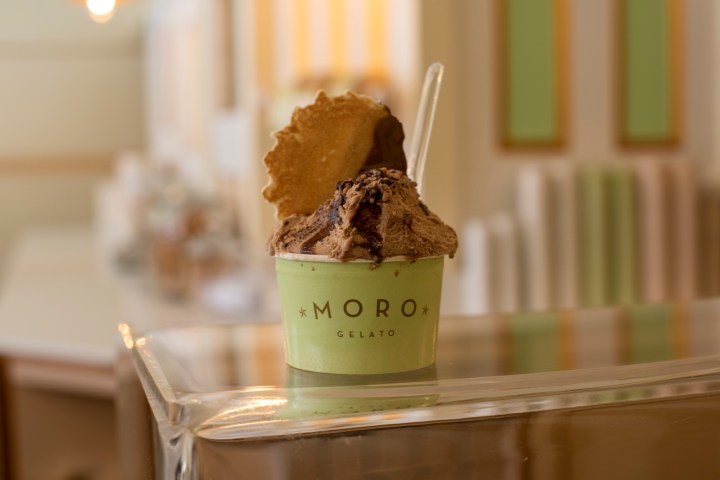
What makes gelato gelato? We all know it’s more than just the Italian word for ice cream, but what actually distinguishes the two? As we talk to two of Cape Town’s artisan producers, Moro Gelato and Kristen’s Kick Ass Ice Cream, the differences between gelato and ice cream, the science and the emotion behind them, come sharply into focus.
So much of our experience of ice cream and gelato is about emotion, creating memories as kids, nostalgic recapturing of childhood memories as adults. The comfort of an ice cream hug is real, the taste of a perfect gelato can transport you in time and place.
My childhood memories of ice cream start with the magnetic lure of the ice cream van parked at one of our family Sunday walk spots, where the biggest decision was whether we could run to a flake in the soft serve, artisan ice cream it was not. But there was also my grandmother’s homemade vanilla ice cream, fresh cream and plain vanilla simplicity, served with a conspiratorial wink to spoil us on our annual visits. I can still taste it now.
Gelato I first experienced as an 18-year-old exchange student living with a family outside Milan, with barely a few words of Italian. The family had a weekend ritual of taking home a huge tub from the local gelateria filled with scoops of at least 10 different flavours that were deliberated over carefully, always cioccolato, nocciola, caffé, but then which fruits, and should stracciatella make the selection, this was something that didn’t need translation. The rainbow of flavours, strawberry, apricot or peach that tasted of the actual ripe fruits made gelato seem way more exciting and sophisticated than plain old ice cream, but I didn’t stop to wonder why those flavours tasted so fresh and appealing.
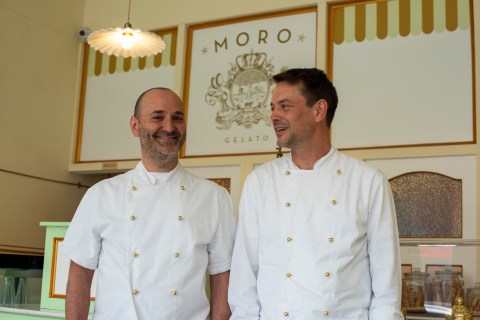
Stefano Moro and Heine van Wyk bring the best of Italian gelato artisan tradition to Cape Town. (Photo: Patrick Heathcock)
Many years later and half the world away, I’m at Moro Gelato in Sea Point’s Regent Road to find out more from Stefano Moro and Heine van Wyk. Having met in Milan, where Stefano was a fashion photographer and Heine a model and designer, opening a gelateria was never part of their plan, until Stefano’s parents visiting them in Cape Town found there was nowhere to go for proper gelato. It was clearly their duty to remedy that. They learned their skills from the best, at the Sorbetteria Castiglione in Bologna, then began selling from a gelato cart at Cape Town markets, opening their first shop in Long Street in 2017. Now they have three Cape Town shops all with the same old-world elegance inspired by Pasticceria Lanfranchi in Cremona, decorated in pastel pistachio, cream and gold. There’s a chocolate fountain to coat the crisp round wafers that crown the cone, gleaming gold lids over the gelato pozzetti, gold lettering on the boards that describe the flavours of the week – just walking in is a sensual delight.
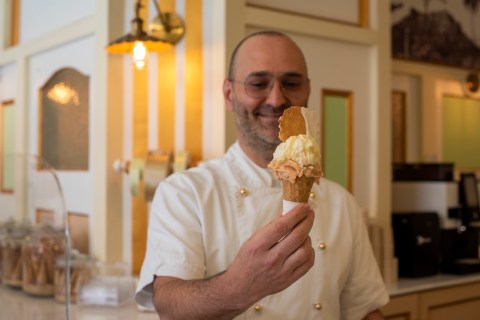
Stefano serves us a lemon meringue gelato paired with pesca sorbetto in a cone, light, fresh and intensely satisfying. (Photo: Patrick Heathcock)
Living and working between Milan and Cape Town has given Heine and Stefano a particular take on gelato. “It’s our strength having the Italian heart and South African hands,” says Stefano. “I don’t want to just have the classic Italian flavours you find in Roma or Milano, I want something from Cape Town.” So alongside pure Italian classics such as pistacchio and caffé, you might find rooibos, lemon meringue, hertzoggie cookie, innovative combinations that take the spirit of gelato and translate it into a South African idiom. “The truth of being Italian is having the patience and passion for the quality of the product that you make, it’s not just that we come from somewhere that looks like a boot.”
And the spirit of artisanal gelato is something Stefano takes very seriously. When I ask him to explain the difference between gelato and ice cream, he says, “Think of McDonald’s and La Colombe. Fast food, or chef-driven, quality food with good ingredients. Ice cream came from gelato making. To make it more commercial they took shortcuts, put in flavourings, colourants, hydrogenated fats, things to fluff it up. There’s a lot of air inside it.”
He’s talking about commercial ice cream here of course, but there are still big differences between gelato and proper artisan ice cream. “Gelato has less fat and less sugar than ice cream, because we ‘cook’ gelato at a temperature of -12°C, whereas ice cream is at -18°C. Sugar acts as an anti-freeze, so that 6 degree gap needs more sugar to keep the ice cream soft.” The lower fat content, 6-9% for gelato as opposed to 14 -18% for ice cream, isn’t anything to do with health considerations and all to do with showcasing flavours. “To me,” Stefano says, “the quantity of fat in ice cream numbs your tongue, so you don’t taste the flavour of the good stuff, like the chocolate, so well.”
For Stefano and Heine gelato is all about freshness, high quality ingredients and absolutely no preservatives or colourants. “We make it today to sell today, not in six months, it doesn’t sit in the deep freeze,” says Stefano. “It’s more work but the quality is higher.” In keeping with this they use local ingredients, whole fresh fruits in season, never jams, frozen pulps or syrups. The only things they import are the machinery, then three ingredients that they feel can’t be equalled locally – chocolate from Belgium, hazelnuts from Italy, pistachios from Sicily, “The best pistachios are from Bronte, a small area on the volcano Etna, so the roots are in the lava. They have a special flavour not like the Turkish ones.”
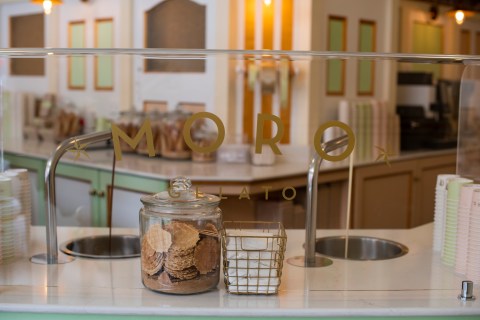
Each cone or cup is crowned with a wafer coated in Belgian chocolate from the constantly running chocolate fountain. (Photo: Patrick Heathcock)
Stefano’s love for gelato and preference for Belgian chocolate are rooted in his childhood. His nonna would make gelato on seaside holidays in Portofino on the Ligurian coast of Italy, where they went to escape the oppressive summer heat back home in Milan. The bicycle on the Moro Gelato crest references this. “My grandmother used to receive the fresh eggs and milk by bicycle from the delivery guy – she would scream from the window ‘Giacomo, tre uova, three eggs,’ and then we knew she was going to make gelato for us.” The eggs were to make her crema gelato, based on the light Italian custard used to fill pastries. Cioccolato was Stefano’s favourite childhood flavour and for this, he recalls, she insisted that only Belgian chocolate had the correct balance of flavour without the bitter burnt taste of too many dark chocolates.

True artisan gelato should be served straight from the covered pozzetti which protects its freshness from exposure to light, heat and air, Stefano tells us. (Photo: Kit Heathcock)
At Moro Gelato the gelato is hidden away under decorative gold lids, your selection driven by the mouthwatering descriptions on the board rather than visual temptation. These pozzetti, special freezer serving counters with covered “wells” imported from Italy, are an important indicator of real artisanal gelato, Stefano says. “It’s a fresh product, we need to keep it away from light, temperature fluctuations and air.” He’s scathing about the commercialisation of gelato. “The 80s ruined everything for gelato in Italy, they brought in these big, exposed windows to display the gelato, used preservatives and pre-made syrups. In Venice the main street leading to the Rialto bridge and St Mark’s Square is lined with these gelato shops, people come once in a lifetime, they don’t care.” He advises to search the back streets and find a gelateria that uses covered pozzetti, the mark of an artisan maker with pride in their product.
I have a flashback to a favourite bar in Colle Val d’Elsa in Tuscany. On the rather dull, traffic-filled main piazza of the modern town below the picturesque hilltop village, it wasn’t on the tourist trail, but the gelato put it firmly on our map. A pastel palette of fruit flavours filled one counter display and nuanced shades of caramel, cream and chocolate another; we’d deliberate for ages over the perfect combination of three or four flavours. Perturbed by the lack of pozzetti in my visual memory, I ask Stefano, were they not the real deal after all? He asks when that was. The early 90s. “No, the pozzetti weren’t available back then – everyone had progressed to the modern open display – they only brought them back in the 2000s.” A sigh of relief as my gelato memories are allowed to remain untarnished.
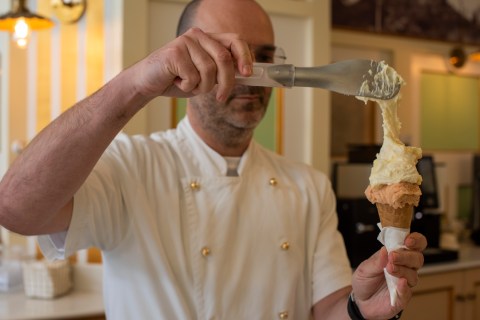
Stefano demonstrates the use of a spatula to serve gelato, which should be soft and easily moulded. ‘Scoops are for snowballs!’ he says. (Photo: Patrick Heathcock)
We have a long consultation about which flavours would pair well. As the lids are ceremonially lifted, I notice that they serve their gelato using a flat spatula rather than a scoop. “To me scoops are for snowballs – snowballs are icy,” says Stefano. “Gelato is soft and creamy, you need to use a spatula. It takes a lot of technique to fill a cone and not break them.”
Bacio di Dama, one of their new flavours, turns out to be a gorgeous hazelnut gelato with chocolate ganache running through it, toasted almonds covered in chocolate for texture and crunch. It goes beautifully with Caramel Cookie Crumble, a cinnamon hug of speculoos warmth. Having shared this deliciousness with my photographer husband through the conversation, though admittedly I have the lion’s share, we still need to photograph and sample a cone. Stefano wants us to try the new lemon meringue, torn between pairing it with their signature Marchese – vanilla, macadamia and almond – which I’ve had before and love, or one of the fruit sorbetti, pesca perhaps. It’s better than any lemon meringue dessert I’ve tasted – not to diss this iconic dessert, but I usually find it a bit too acid on the one side and sickly sweet on the other – the gelato brings the lemon into balance with some biscuit butteriness and a whole lot of mellow. And the pesca is like eating a perfectly ripe nectarine without the hassle of juice running down your chin. Gelato perfection.

Kristen Buttress shares her enthusiasm for fresh local ingredients and the complex science behind ice cream at her Newlands store. (Photo: Patrick Heathcock)
A week later we head to the newest outlet of Kristen’s Kick Ass Ice Cream in Newlands to hear the ice cream side of the story. What started as a hobby, making ice cream in a countertop mixer to take to dinner parties, has become an all-consuming passion for Kristen Buttress. It began in 2015 when Franck Dangereux of Food Barn asked her to open a shop at Noordhoek Farm Village. “I said sure no problem, and then I googled how to open an ice cream shop,” she laughs. “I’m still figuring it out as I go.” Now with three Cape Town stores, one in Mauritius, and an online ice cream delivery service, the figuring it out is clearly working. Kristen says she’s obsessed with the science of ice cream, currently taking a bunch of online classes to learn more of the technical aspects, such as the complexities of adding alcohol without impacting the texture. I ask for her take on the differences between gelato and ice cream.
“American-style ice cream is going to have more fat than gelato – 14% or above,” she says, “it’s going to be served at a colder temperature and will feel more dense because it’s colder, even though there is usually more air in it – we call that overrun in ice cream making. For my ice cream, I have a higher fat percentage but I churn with a lower overrun so my ice cream is denser without the air. I use Italian equipment, so although I have American-centric flavours, chocolate chip cookie dough, lots of stuff in the ice cream, I think my processes are a bit more Italian.”

Generous scoops of Kristen’s KickAss Ice Cream – roasted cherry and chocolate, the fruit intensified by slow roasting, and almond brittle with chocolate ganache. (Photo: Patrick Heathcock)
As she continues to explain I get a lightbulb moment of how something that is perceived as a disadvantage from a gelato perspective can be a positive advantage for the ice cream maker.
“The thing about the fat – you have water-soluble flavours and you have fat-soluble flavours. So with a higher fat content ice cream you’re going to have what I call a Willy Wonka never-ending gobstopper experience: you have a forward note, a middle note and an end note. Cinnamon, chocolate and cayenne is an interesting example of that, with one lick you will get three different taste experiences and that’s because of your fat content. With a lower fat content, for example a strawberry gelato, you’ll get a really bright strawberry flavour. If you put in more butterfat you will mute the strawberry flavour but it’s going to be a lot more creamy, with a lingering flavour on the palate. So the eating experience is different between the two. It’s so cool.”
The science gets more complex as Kristen explains the sugar factors at work. “If you look at a graph between sucrose, fructose and glucose, fructose will hit your palate much faster, sucrose is longer lasting and stays with your taste buds longer. That’s why I’m taking all these classes at the moment, I’m learning how these things intermingle and to potentially use technical sugars to create the ultimate ice cream. I’m obsessed with it.”
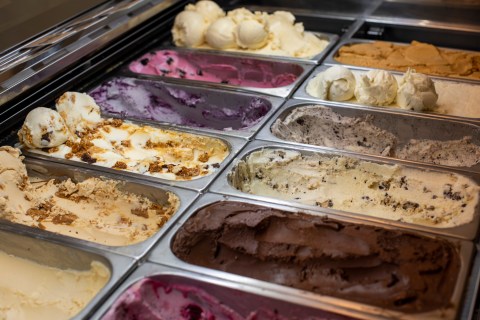
Kristen’s ice cream flavours rotate through the seasons according to fresh local ingredients available. (Photo: Patrick Heathcock)
Kristen identifies one more difference between the two that is more about the emotion and the eating experience, “Ice cream is a hard lick, it’s on a cone, you lick it, it takes forever, it doesn’t melt as fast. Gelato you need to eat more quickly as it’s served at a higher temperature.”
Besides Kristen’s excitement in delving deep into the science of ice cream, childhood nostalgia is clearly a driving force behind the feel of her brand.
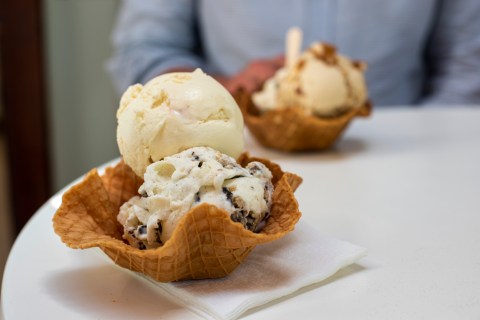
Homemade wafer bowls and two huge scoops – a real sit down treat at the outside tables of the Newlands store. (Photo: Patrick Heathcock)
“As a child I loved all the ice creams that had all the stuff in them, the more stuff the better – that’s why my ratio of ice cream to inclusions is like 50/50. My parents would bring home a tub and we’d take turns scooping and I was the kid who would put all of the cookie dough into my bowl. If it had the word unicorn on it or glitter, that was me.”
She bakes everything that goes into the ice creams from scratch – chocolate cake, cookie dough, honeycomb, almond brittle. “On the one side we’ve got this fancy almond brittle and salted chocolate ganache ice cream, it’s delicious and beautiful, but the kids don’t like it. So we also have blue ice cream with glitter and marshmallows, bubblegum flavour. Under the age of 12 you don’t even have to ask them what they’re going to get!” And she’s not too proud to serve sprinkles on demand. “Sprinkles are free, and if you get halfway through your scoop and want more sprinkles, we’ll load you up.”
While Kristen says they don’t take themselves too seriously, and our conversation is peppered with lots of laughter, she’s serious enough to have developed their own cone recipe with proper butter and muscovado sugar, baked fresh in each store daily. And serious enough only to use fresh local ingredients, including Afrikoa chocolate. She’s also constantly creating new flavours in her home “test” kitchen, “I need to stop coming up with new flavours! I’ve got like 80 and we only have 16 slots in the shop.”

Each store bakes their cones and wafer bowls fresh each day to a recipe Kristen developed using real butter and muscovado sugar. (Photo: Patrick Heathcock)
While we chat there’s a procession of customers at the counter, small kids emerging with sprinkle coated baby scoops, older kids sitting down to the sophistication of elaborate wafer cups holding two of the huge regular scoops, then an elderly gentleman who comes in every single day for a scoop of their best-selling honeycomb and chocolate chip ice cream.
I fall badly for the roasted cherry and chocolate, the fruit intensified by slow roasting, and I can’t resist the almond brittle with chocolate ganache, enormous scoops piled into a deliciously crispy wafer cone. Luscious, generous and decadent.
“Ice cream is just happiness, it’s so cliché but ice cream makes everything better,” Kristen concludes. “You go ride your bikes with your friends and go get an ice cream, or your mom or dad takes you after school. It’s always a treat and a moment you can share with somebody, I just love that.”
Both these forces for frozen goodness seem happily to be unstoppable – 2022 sees a new branch for each of them. Kristen launches a new store in Stellenbosch today (Friday, February 4), and Heine and Stefano will be bringing Moro Gelato to the Southern Suburbs of Cape Town later this year. DM/TGIFood
Read more about Moro Gelato here
Order Kristen’s Kick Ass Ice cream online here
Follow Kit on Instagram @kitheathcock



 Become an Insider
Become an Insider
Moro is legit!